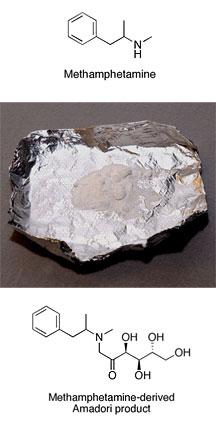

A New Wrinkle in Methamphetamine Abuse: Immune Tolerance
By Jason Socrates Bardi
Researchers at The Scripps Research Institute have discovered that the immune system may be able to recognize the drug methamphetamine—a hypothesis that, if true, could have implications for understanding why methamphetamine users go on long binges with the drug.
In an article to be published in the Journal of the American Chemical Society, the researchers describe how in the test tube, methamphetamine is able to spontaneously react with glucose, the body’s main source of energy and an abundant molecule in the bloodstream.
When they react, the glucose and the methamphetamine molecules become permanently attached to one another, forming a “glycated” product. These glycated products then attach to proteins, making glycated proteins. And the presence of glycated proteins in the bloodstream can lead to a response from the immune system, stimulating the production of antibodies that recognize the glycated form of methamphetamine.
"Glycation acts like a linker that allows [the methamphetamine] to be displayed to the immune system,” says principle investigator Kim Janda, who holds the Ely R. Callaway, Jr. Chair in Chemistry at Scripps Research. “People who abuse methamphetamine may be vaccinating themselves against the drug.”
This might be one way that the body acquires resistance, Janda says, and may have implications for why methamphetamine addicts go on long binges. If the antibodies prevent some of the drug from reaching its place of action in the brain, addicts might require more of the drug because some of it is bound up by antibodies.
Janda is an investigator in The Skaggs Institute for Chemical Biology at Scripps Research, and he led the study with his former student Tobin Dickerson, Ph.D., who is a graduate of the Scripps Research Kellogg School of Science and Technology.
A Drug with Many Names and Many Effects
Methamphetamine is the potent psychostimulant that has been referred to for years by its common name, speed, and more recently by a spate of street-wise terms like ice, crank, crystal, meth, and glass.
Its use is widespread.
According to the National Survey on Drug Use and Health, a report described on the website of the National Institute on Drug Abuse (NIDA), more than 12.4 million Americans have tried methamphetamine at least once. One of the biggest factors contributing to this use is that it can be manufactured relatively easily in homemade laboratories from inexpensive over-the-counter medicines and other readily available chemicals.
Once made, the drug is injected, snorted, swallowed, or smoked and creates a sense of euphoria, increased activity, decreased appetite, and often high agitation in its users. The euphoria is linked to the drug’s action in the nucleus accumbens—the so-called pleasure center of the brain—and the frontal cortex, where it releases an excess of the neurotransmitter dopamine.
The release of dopamine may have the desired stimulatory effect on the mind and body, but it is thought to have toxic side effects as well. NIDA reports on its website that research has shown methamphetamine use damages neuronal termini in the brain. The institute also lists several negative side-effects, including irritability, sleeplessness, confusion, tremors, convulsions, anxiety, paranoia, and aggressiveness. Methamphetamine can also damage blood vessels in the brain and cause strokes.
Amplifying the danger of these side effects is the fact that methamphetamine is also highly addictive. Chronic methamphetamine users often go on binges in which they might stay up for several days taking the drug.
Methamphetamine remains in the bloodstream for long periods of time after a user ingests it. NIDA reports that as much as 50 percent remains in the bloodstream 12 hours post-use. This fact interested Dickerson and Janda, since they have studied the effect of other substances that have long half-lives in the bloodstream, such as nicotine.
In this case, the researchers essentially mixed methamphetamine with glucose in the test tube and demonstrated that methamphetamine can indeed react with the glucose to make what are known as glycation products. These glycation products could then react with proteins and produce glycated proteins.
Dickerson and Janda wondered what effect this might have in the bloodstream. So they took some of these glycated protein products and delivered them in vivo to mice. The results showed that the presence of glycated proteins in the mouse models caused antibodies against the glycated proteins to appear.
When they isolated the antibodies and tested them, Dickerson and Janda discovered that they could recognize the glycated structure.
What this suggests, says Janda, is that since methamphetamines may react with proteins and induce an immune response; perhaps the body naturally has the ability to generate antibodies that may counteract methamphetamine. If the mechanism the scientists are proposing is correct, then addicts are in essence vaccinating themselves against the drug when they use it.
Any such tolerance would be in addition to neurological tolerance, which while not entirely understood is known to operate differently.
To read the article, “Immunological Consequences of Methamphetamine Protein Glycation” by Tobin J. Dickerson, Noboru Yamamoto, Diana I. Ruiz, and Kim D. Janda, see the Journal of the American Chemical Society (2004), Vol. 126, page 11446-7, or go to: http://dx.doi.org/10.1021/ja047690h.
Send comments to: jasonb@scripps.edu

Scripps Research Professor Kim Janda (above) and his former graduate student Tobin Dickerson have published research on methamphetamine that suggests why methamphetamine users go on long binges.

Methamphetamine is shown above as a chemical structure, powder form (image courtesy of the DEA), and a "Amdori" product after it has combined with glucose.
